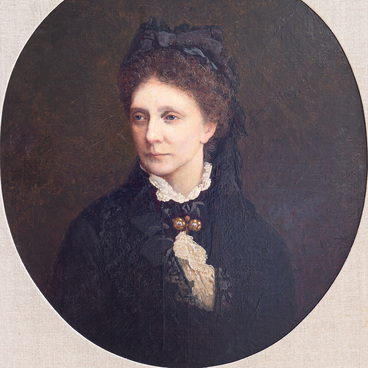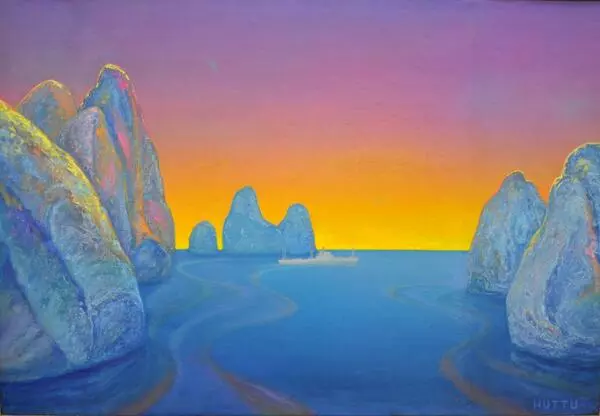Arvi Huttunen was born in the Petrograd governorate on August 31, 1922.
In August 1941, he was drafted into the army. In 1942, he was sent to Chelyabinsk to work at the construction of a metallurgical plant.
In 1947, he moved to Murmansk, where he got a job at school as an Art and Technical Drawing teacher.
In 1963, he graduated with honors from the Leningrad Institute of Painting, Sculpture and Architecture named after I.E. Repin, majoring in art criticism.
The artist developed projects of the restoration and interior design for many public buildings in the Murmansk region.
In the late 1970s, the desire to acquire new artistic experience prompted Arvi Huttunen to take part in creative expeditions across the Kola Peninsula and beyond. In 1978, Huttunen became founder and leader of a group of Murmansk artists called “Arktika”. The main goal of the artists’ union was to get acquainted with the Arctic and create new works.
In 1982, the artist received the title of Honorary Polar Explorer.
The “Arktika” group sailed through the seven Arctic seas from Murmansk to Provideniya Bay, and from 1978 to 1986 made several trips along the Northern Sea Route several times.
Arvi Huttunen’s landscapes are distinguished by unusual choice of colors. The artist worked mainly in tempera. In his works, the hills, ice, and the sky of the Far North and the Arctic are painted in bright colors and look like a fantastic landscape. His pictures are an unexpected, yet harmonious combination of a rich color palette and a minimalistic composition.
Arvi Huttunen has been an Honored Worker of Culture of the Russian Federation since 2000, and an Honored Artist of the Russian Federation since 2007. In 2008, the artist was awarded the Murmansk Region Governor’s Prize for his special contribution to the development of culture and art. His canvases depicting the nature of the Arctic and the Far North have been exhibited in more than 100 countries.
The works of Arvi Huttunen are housed in the collection of the Murmansk Regional Art Museum, the Murmansk Regional Museum of Local Lore, in institutions and organizations of Murmansk, Petrozavodsk, Moscow, in private collections in Russia and abroad.
In August 1941, he was drafted into the army. In 1942, he was sent to Chelyabinsk to work at the construction of a metallurgical plant.
In 1947, he moved to Murmansk, where he got a job at school as an Art and Technical Drawing teacher.
In 1963, he graduated with honors from the Leningrad Institute of Painting, Sculpture and Architecture named after I.E. Repin, majoring in art criticism.
The artist developed projects of the restoration and interior design for many public buildings in the Murmansk region.
In the late 1970s, the desire to acquire new artistic experience prompted Arvi Huttunen to take part in creative expeditions across the Kola Peninsula and beyond. In 1978, Huttunen became founder and leader of a group of Murmansk artists called “Arktika”. The main goal of the artists’ union was to get acquainted with the Arctic and create new works.
In 1982, the artist received the title of Honorary Polar Explorer.
The “Arktika” group sailed through the seven Arctic seas from Murmansk to Provideniya Bay, and from 1978 to 1986 made several trips along the Northern Sea Route several times.
Arvi Huttunen’s landscapes are distinguished by unusual choice of colors. The artist worked mainly in tempera. In his works, the hills, ice, and the sky of the Far North and the Arctic are painted in bright colors and look like a fantastic landscape. His pictures are an unexpected, yet harmonious combination of a rich color palette and a minimalistic composition.
Arvi Huttunen has been an Honored Worker of Culture of the Russian Federation since 2000, and an Honored Artist of the Russian Federation since 2007. In 2008, the artist was awarded the Murmansk Region Governor’s Prize for his special contribution to the development of culture and art. His canvases depicting the nature of the Arctic and the Far North have been exhibited in more than 100 countries.
The works of Arvi Huttunen are housed in the collection of the Murmansk Regional Art Museum, the Murmansk Regional Museum of Local Lore, in institutions and organizations of Murmansk, Petrozavodsk, Moscow, in private collections in Russia and abroad.






